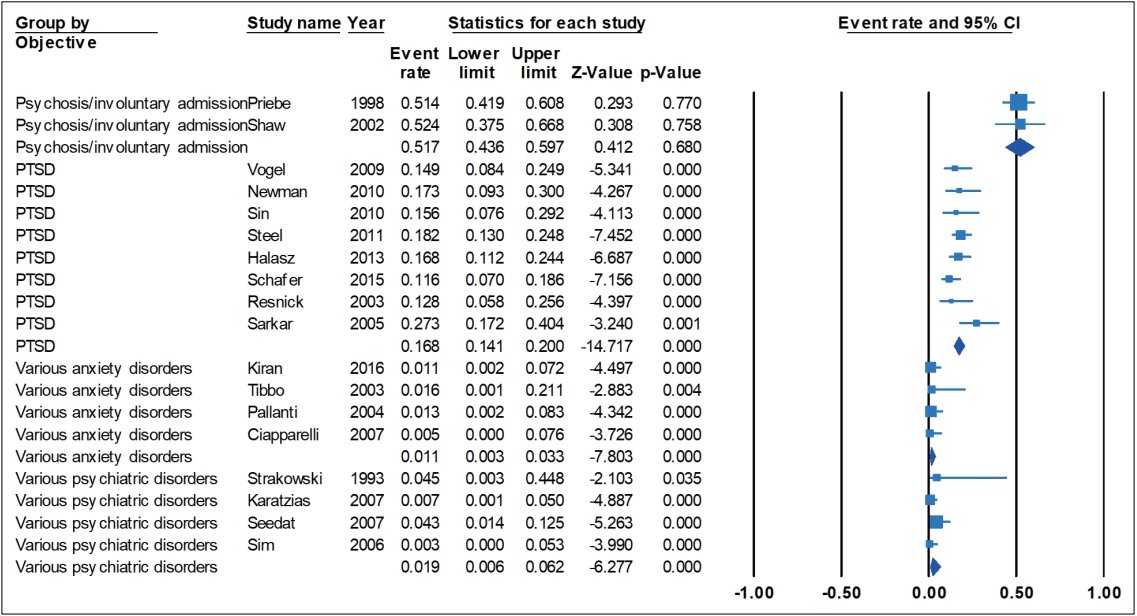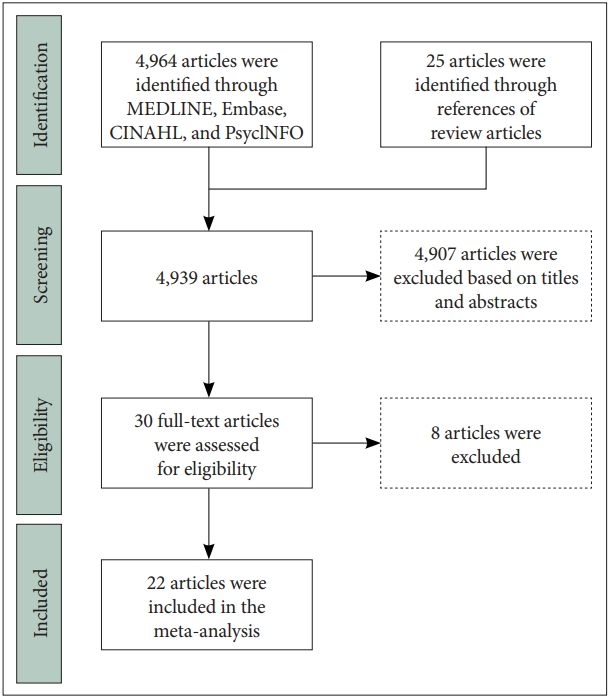 |
 |
- Search
| Psychiatry Investig > Volume 20(6); 2023 > Article |
|
Abstract
Objective
Methods
Results
Conclusion
Notes
Availability of Data and Material
The datasets generated or analyzed during the suty are available from the corresponding author on reasonable request.
Conflicts of Interest
The authors have no potential conflicts of interest to disclose.
Author Contributions
Conceptualization: Anna Seong, Kyoung-Sae Na. Data curation: Anna Seong, Kyoung-Sae Na. Formal analysis: Kyoung-Sae Na. Investigation: all authors. Methodology: all authors. Project administration: Kyoung-Sae Na. Software: Kyoung-Sae Na. Supervision: Kyoung-Sae Na. Validation: Kyoung-Sae Na. Visualization: Kyoung-Sae Na. Writing—original draft: all authors. Writing—review & editing: all authors.
Funding Statement
None
Figure 2.

Figure 3.

Table 1.
| Study | Country | Objective | Recruitment | Total N | PTSD N | Interview | Diagnosis | Prevalence |
|---|---|---|---|---|---|---|---|---|
| Braga et al. [38] (2005) | Brazil | Various anxiety disorders | Consecutive | 53 | 2 | SCID | DSM-IV | Lifetime |
| Ciapparelli et al. [39] (2007) | Italy | Various anxiety disorders | N/A | 98 | 0 | SCID | DSM-IV | Current |
| DeTore et al. [45] (2021) | United States | PTSD | N/A | 404 | 20 | SCID | DSM-IV | Lifetime |
| Halász et al. [46] (2013) | Hungary | PTSD | N/A | 125 | 21 | SCID | DSM-IV | Current |
| Karatzias et al. [42] (2007) | United Kingdom | Various psychiatric disorders | Consecutive | 136 | 1 | SCID | DSM-IV | Current |
| Kiran and Chaudhury [47] (2016) | India | Various anxiety disorders | Consecutive | 93 | 1 | MINI | ICD-10 | Current |
| Neria et al. [48] (2002) | United States | PTSD | N/A | 170 | 17 | SCID | DSM-III-R | Lifetime |
| Newman et al. [49] (2010) | United States | PTSD | Consecutive | 52 | 22 | SCID | DSM-IV | Lifetime |
| 9 | Current | |||||||
| Pallanti et al. [50] (2004) | Italy | Various anxiety disorders | Consecutive | 80 | 1 | SCID | DSM-IV | Current |
| Peleikis et al. [51] (2013) | Norway | PTSD | Consecutive | 292 | 21 | SCID | DSM-IV | Lifetime |
| Priebe et al. [16] (1998) | Germany | Involuntary admission | N/A | 105 | 54 | PTSD-I | DSM-III-R | Current |
| Resnick et al. [52] (2003) | United States | PTSD | N/A | 47 | 6 | CAPS | DSM-IV | Current |
| Sarkar et al. [53] (2005) | United Kingdom | PTSD | N/A | 55 | 22 | PSS-I | DSM-IV | Lifetime |
| 15 | Current | |||||||
| Schäfer et al. [54] (2015) | Germany | PTSD | Consecutive | 121 | 14 | SCID | DSM-IV | Current |
| Seedat et al. [41] (2007) | South Africa | Various psychiatric disorders | Consecutive | 70 | 3 | MINI | DSM-IV | Current |
| Shaw et al. [17] (2002) | Australia | Psychotic experiences | Consecutive | 42 | 22 | CAPS | DSM-III-R | Current |
| Sim et al. [44] (2006) | Singapore | Various psychiatric disorders | Consecutive | 142 | 0 | SCID | DSM-IV | Current |
| Sin et al. [57] (2010) | Singapore | PTSD | N/A | 45 | 7 | CAPS | DSM-IV-TR | Current |
| Steel et al. [55] (2011) | United Kingdom | PTSD | N/A | 165 | 30 | CAPS | DSM-IV | Current |
| Strakowski et al. [40] (1993) | United States | Various psychiatric disorders | Consecutive | 10 | 0 | SCID | DSM-III-R | Current |
| Tibbo et al. [43] (2003) | Canada | Various anxiety disorders | N/A | 30 | 0 | MINI | DSM-IV | Current |
| Vogel et al. [56] (2009) | Germany | PTSD | Consecutive | 74 | 11 | SCID | DSM-III-R | Current |
PTSD, posttraumatic stress disorder; N, number; N/A, not available; DSM, Diagnostic and Statistical Manual; SCID, Structured Clinical Interview for DSM Disorders; MINI, Mini International Neuropsychiatric Interview; ICD-10, International Classification of Diseases, 10th revision; CAPS, Clinician-Administered PTSD Scale; PTSD-I, PTSD Interview; PSS-I, PTSD Symptom Scale-Interview
Table 2.
| Study | 1. Was the study’s target population a close representation of the national population in relation to relevant variables? | 2. Was the sampling frame a true or close representation of the target population? | 3. Was some form of random selection used to select the sample, OR was a census | 4. Was the likelihood of nonresponse bias minimal? | 5. Were data collected directly from the subjects (as opposed to a proxy)? | 6. Was an acceptable case definition used in the study? | 7. Was the study instrument that measured the parameter of interest shown to have validity and reliability? | 8. Was the same mode of data collection used for all | 9. Was the length of the shortest prevalence period for the parameter of interest appropriate? | 10. Were the numerator(s) and denominator(s) for the parameter of interest | 11. Summary item on the overall risk of study bias |
|---|---|---|---|---|---|---|---|---|---|---|---|
| Braga et al. [38] (2005) | No | No | No | No | Yes | Yes | Yes | Yes | No | Yes | High |
| Ciapparelli et al. [39] (2007) | No | No | Yes | No | Yes | Yes | No | Yes | Yes | Yes | Moderate |
| DeTore et al. [45] (2021) | Yes | Yes | Yes | No | Yes | Yes | Yes | Yes | No | Yes | Low |
| Halász et al. [46] (2013) | No | No | No | No | Yes | No | Yes | Yes | Yes | No | High |
| Karatzias et al. [42] (2007) | No | No | Yes | No | No | Yes | Yes | No | Yes | Yes | High |
| Kiran and Chaudhury [47] (2016) | No | No | No | No | Yes | No | Yes | No | Yes | Yes | High |
| Neria et al. [48] (2002) | No | No | No | No | No | No | No | No | No | Yes | High |
| Newman et al. [49] (2010) | No | No | No | No | No | Yes | Yes | No | No | Yes | High |
| Pallanti et al. [50] (2004) | No | No | No | No | Yes | No | No | No | Yes | Yes | High |
| Peleikis et al. [51] (2013) | No | Yes | Yes | No | Yes | Yes | Yes | Yes | No | Yes | Moderate |
| Priebe et al. [16] (1998) | No | No | No | No | No | Yes | Yes | Yes | Yes | Yes | High |
| Resnick et al. [52] (2003) | No | No | No | No | Yes | Yes | Yes | No | Yes | Yes | High |
| Sarkar et al. [53] (2005) | No | No | No | No | Yes | Yes | Yes | Yes | No | Yes | High |
| Schäfer et al. [54] (2015) | No | No | Yes | No | Yes | Yes | Yes | Yes | Yes | Yes | Moderate |
| Seedat et al. [41] (2007) | No | No | No | No | Yes | Yes | Yes | No | Yes | Yes | High |
| Shaw et al. [17] (2002) | No | No | Yes | No | Yes | Yes | Yes | Yes | Yes | Yes | Moderate |
| Sim et al. [44] (2006) | No | No | Yes | No | Yes | Yes | Yes | No | Yes | Yes | Moderate |
| Sin et al. [57] (2010) | No | No | No | No | Yes | Yes | Yes | Yes | Yes | Yes | Moderate |
| Steel et al. [55] (2011) | No | No | Yes | No | Yes | Yes | Yes | Yes | Yes | Yes | Moderate |
| Strakowski et al. [40] (1993) | No | No | Yes | No | Yes | No | No | Yes | Yes | Yes | High |
| Tibbo et al. [43] (2003) | No | No | No | No | Yes | No | Yes | Yes | Yes | Yes | High |
| Vogel et al. [56] (2009) | No | No | Yes | Yes | Yes | Yes | Yes | Yes | Yes | Yes | Low |
Table 3.
N, number; CI, confidence interval; PTSD, posttraumatic stress disorder; DSM, Diagnostic and Statistical Manual; ICD-10, International Classification of Diseases, 10th Revision; CAPS, Clinician-Administered PTSD Scale; MINI, Mini International Neuropsychiatric Interview; SCID, Structured Clinical Interview for DSM Disorders; PSS-I, PTSD Symptom Scale-Interview; PTSD-I, PTSD Interview
REFERENCES








